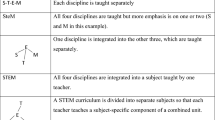Abstract
In How High School Students Envision Their STEM Career Pathways, Lin Zhang and Michael Barnett attempt to shed light on the problem of underrepresented students (e.g., Aboriginals, Hispanics, African Americans, urban, females) in STEM higher education and related careers by exploring, in general terms, five high school students’ career visions and the experiences that influenced their career visions. In this paper, I attempt to extend the authors’ discussions on the underrepresentation of minority students in STEM higher education by highlighting some of the factors that begin to influence youths’ career decisions long before they reach the high school level and are required to make specific career choices. I also draw on Glen Aikenhead’s Sci Edu, 27, 1–52 (1996) notion of border crossing and research by Victoria Costa Sci Edu, 79, 313–333 (1995) to reflect on the significance of the relationship between students’ cultural worlds and the cultural world of school science.
Similar content being viewed by others
References
Aikenhead, G. (1996). Border crossing into the subculture of science. Science Education, 27, 1–52.
Baker, D., & Leary, R. (1995). Letting girls speak out about science. Journal of Research in Science Teaching, 32, 3–27. doi:10.1002/tea.3660320104.
Barman, C. (1997). Students’ views of scientists and science: Results from a national study. Science and Children, 35, 18–23.
Bronfenbrenner, U. (1995). Developmental ecology through space and time: A future perspective. In P. Moen, G.H.Elder, & K. Luscher (Eds.), Examining lives in context: Perspectives on the ecology of human development (pp. 619–647). Washington, DC: American Psychological Association. doi:10.1037/10176-018.
Carlone, H., & Johnson, A. (2007). Understanding the science experiences of successful women of color: Science identity as an analytic lens. Journal of Research in Science Teaching, 44, 1187–1218. doi:10.1002/tea.20237.
Costa, V. (1995). When science is “another world”: Relationships between worlds of family, friends, school, and science. Science Education, 79, 313–333.
Diekman, A., Brown, E., Johnston, A., & Clark, E. (2010). Seeking congruity between goals and roles: A new look at why women opt out of science, technology, engineering, and mathematics careers. Psychological Science, 21, 1051–1057.
English, L., Hudson, P., & Dawes, L. (2011). Middle school students’ perceptions of engineering. In P. Hudson, & C. Vinesh (Eds.), STEM in Education Conference: Science, Technology, Engineering and Mathematics in Education Conference, Queensland University of Technology, Queensland University of Technology, Brisbane, Qld. Retrieved on July 27, 2013 from http://eprints.qut.edu.au/44086/.
Gottfredson, L. (1981). Circumscription and compromise: A developmental theory of occupational aspirations. Journal of Counselling Psychology, 28, 545–579. doi:10.1037/0022-0167.28.6.545.
Hodson, D. (1998). Teaching and learning science: Towards a personalized approach. Buckingham: Open University Press.
Huber, R., & Burton, G. (1995). What do students think scientists look like? School Science and Mathematics, 95, 371–376. doi:10.1111/j.1949-8594.1995.tb15804.x.
Jones, M., Howe, A., & Rua, M. (2000). Gender differences in students’ experiences, interests, and attitudes toward science and scientists. Science Education, 84, 180–192. doi:10.1002/(SICI)1098-237X(200003)84:2<180:AID-SCE3>3.0.CO;2-X.
Ladany, N., Melincoff, D., Constantine, M., & Love, R. (1997). At-risk urban high school students’ commitment to career choices. Journal of Counseling and Development, 76, 45–52. doi:10.1002/j.1556-6676.1997.tb02375.x.
Mead, M., & Metraux, R. (1957). The image of the scientist among high school students: A pilot study. Science, 126, 384–390. doi:10.1126/science.126.3270.384.
Phelan, P., Davidson, A., & Yu, H. (1993). Students’ multiple worlds: Negotiating the boundaries of family, peer, and school cultures. Anthropology and Education Quarterly, 22, 224–250. doi:10.1525/aeq.1991.22.3.05x1051k.
Smith, W., & Erb, T. O. (1986). Effect of women science career role models on early adolescents’ attitudes toward scientists and women in science. Journal of Research in Science Teaching, 8, 667–676. doi:10.1002/tea.3660230802.
Author information
Authors and Affiliations
Corresponding author
Additional information
Lead Editor: B. Cowie.
This review essay addresses issues raised in the L. Zhang and M. Barnett’s paper entitled: How high school students envision their STEM career pathways. doi:10.1007/s11422-013-9557-9.
Rights and permissions
About this article
Cite this article
Sharkawy, A. Envisioning a career in science, technology, engineering and mathematics: some challenges and possibilities. Cult Stud of Sci Educ 10, 657–664 (2015). https://doi.org/10.1007/s11422-014-9636-6
Received:
Accepted:
Published:
Issue Date:
DOI: https://doi.org/10.1007/s11422-014-9636-6




